

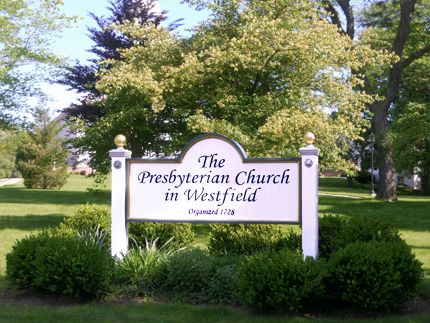
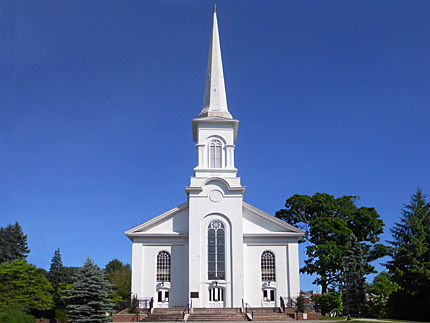
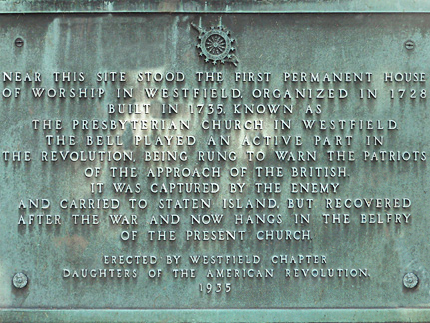
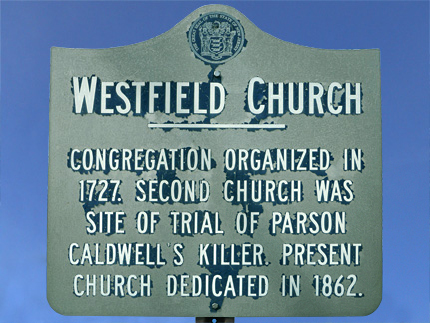
Presbyterian Church in Westfield and Cemetery
140 Mountain Ave.
Map / Directions to the Presbyterian Church of Westfield
Map / Directions to all Westfield Revolutionary War Sites
The Presbyterian Church in Westfield [1]
The church building that stands here today is actually the fourth Westfield Presbyterian Church building. The first was a log church built in 1728; it stood about a half mile from here on what is now Benson Place. The log church was replaced circa 1734-1735 by a second church structure which was located on the opposite corner of Mountain Ave and East Broad St. It was that church building that saw Revolutionary War activity. Many of its members fought in the war, and seventy-one Revolutionary War veterans are known to be buried in the cemetery.
The Revolutionary War-era church was replaced by a third building in 1805, located in front of where the current church sits. Finally, in 1862 the current church was completed.
Two notable events which occurred in the Revolutionary War-era church are described below:
JUNE 26, 1777
Westfield is occupied by British forces at the end of the Battle of the Short Hills
They occupy and damage the church, and they steal the church bell [2]
The Battle of the Short Hills was fought on June 26, 1777. [3] At the end of the fighting, British forces were in Westfield, where they would stay encamped until the following morning. In 1777, the church building was occupied by British troops. They did a great deal of damage in Westfield, including damage done to the church.
Militiaman Jacob Ludlum, who fought at the Battle of the Short Hills, later recalled that "The British destroyed much private household property wantonly + besides killed vast numbers of sheep, hogs + cattle. They filled the church with a flock of sheep, placed an old Ram's head with a huge pair of horns in the pulpit + carried away the bell." [4]
(Ludlum is buried in the church's cemetery. See the Revolutionary War Veterans Buried in the Church Cemetery section lower on this page.)
The church bell was taken by the British troops and brought with them to New York City, which was occupied for the British for most of the Revolutionary War. The following account of what happened with the bell is from an 1839 history of the church by its then-pastor, James M. Huntting: [5]
"The bell was thrown out of the steeple to the ground without injury, and carried to New York. It was peculiarly fine toned, and was often heard before it was carried away, by the inhabitants of Staten Island and Chatham Village. On the first Sabbath that it was in New York, as the bells of the city began to ring for church, William Clark Esq., who was then a prisoner in the city, heard it and immediately remarked to his fellow prisoners 'that the Westfield bell must have found its way to the city.' By others who had heard it here, its ringing there was noticed, and on the return of peace, it was sought and found. As it had the name of the Parish cast on it, it was readily given up and brought back, but before it was replaced in the belfry it was broken, and materially injured."
In 1847, a new church bell was cast, using metal which had been melted down from the original bell. That 1847 bell still hangs in the current church's steeple. So although the current church bell is not the same one involved in the Revolutionary War, it does contain the same metal.
JANUARY 21, 1782
James Morgan is tried for the murder of James Caldwell at the Presbyterian Church in Westfield [6]
Reverend James Caldwell, known during the Revolutionary War as the "Fighting Parson," was killed by an American sentry named James Morgan on November 24, 1781. A trial for Morgan was held at this church on January 21, 1782; he was found guilty and sentenced to death. Eight days later, he was hanged a short distance from the church on Gallows Hill. (See Gallows Hill entry lower on this page.)
James Caldwell had an interesting Revolutionary War history, with connections to historic sites throughout Union and Essex County:
• He was instrumental in forming the Presbyterian Church in Caldwell, and the town was named for him.
• He was pastor of the First Presbyterian Church in Elizabeth, which was burned by the British on January 25, 1780. Both he and his wife Hannah are buried in that church's cemetery.
• His wife Hannah was killed by a British soldier at the Caldwell's house in Union, June 7, 1780.
• He was at the Battle of Springfield, June 23, 1780
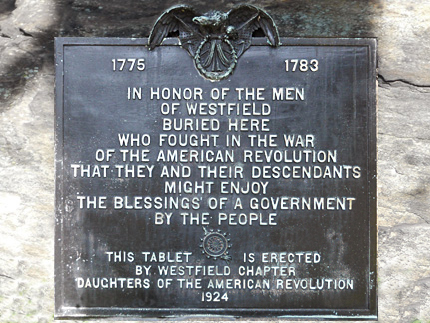
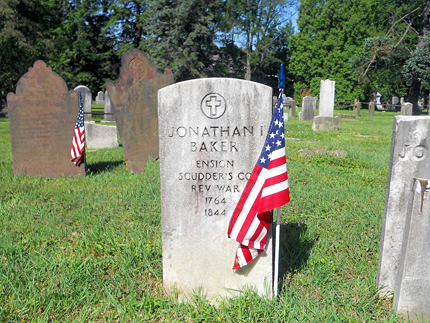
| Jonathan Acken Joseph Acken Robert Acken Anthony Badgley James Badgley Daniel Baker Henry Baker Jonathan Baker Azariah Clark Capt. Charles Clark Charles Clark Edward Clark Ichabod Clark Jacob Clark Jesse Clark Matthias Clark William Clark Joseph Cory Benjamin Crane Sr. Benjamin Crane Jr. John Crane * John Crane * Jacob Davis John Davis 3rd Samuel Downer Jr. Samuel Downer Christopher Denman John Dunham Dr. Philemon Elmer Jonas Frazee Matthias Frazee Charles Gillman Aaron Hatfield Andrew Hetfield Daniel Hetfield Moses Hetfield |
Zopher Hetfield Isaac Hendricks John High Zebulon Jennings Jr. James Lambert Isaac Littell Jacob Ludlum Noah Marsh Charles Marsh Ephram Marsh Joshua Marsh Caleb Maxwell Moses McMannis Abner Isaac Miller Clark Miller Enoch Miller William Miller 3rd Nicholas Mooney Rice Price Silvanus Pierson William Pierson David Ross Matthias Sayres Ephraim Scudder John Scudder * John Scudder * Eleazer Squier Thomas Squier Thomas Terry Benjamin Williams Squire Williams Aaron Woodruff Jonathan Woodruff Richard Woodruff Thomas Woodruff |
|
| Jonathan Acken Joseph Acken Robert Acken Anthony Badgley James Badgley Daniel Baker Henry Baker Jonathan Baker Azariah Clark Capt. Charles Clark Charles Clark Edward Clark Ichabod Clark Jacob Clark Jesse Clark Matthias Clark William Clark Joseph Cory Benjamin Crane Sr. Benjamin Crane Jr. John Crane * John Crane * Jacob Davis John Davis 3rd Samuel Downer Jr. Samuel Downer Christopher Denman John Dunham Dr. Philemon Elmer Jonas Frazee Matthias Frazee Charles Gillman Aaron Hatfield Andrew Hetfield Daniel Hetfield Moses Hetfield Zopher Hetfield Isaac Hendricks John High Zebulon Jennings Jr. James Lambert Isaac Littell Jacob Ludlum Noah Marsh Charles Marsh Ephram Marsh Joshua Marsh Caleb Maxwell Moses McMannis Abner Isaac Miller Clark Miller Enoch Miller William Miller 3rd Nicholas Mooney Rice Price Silvanus Pierson William Pierson David Ross Matthias Sayres Ephraim Scudder John Scudder * John Scudder * Eleazer Squier Thomas Squier Thomas Terry Benjamin Williams Squire Williams Aaron Woodruff Jonathan Woodruff Richard Woodruff Thomas Woodruff |
||
Also buried here are Gershom and Elizabeth "Aunt Betty" Frazee, whose house played a role in the Battle of the Short Hills. For information, see the Frazee House entry on the Scotch Plains page.

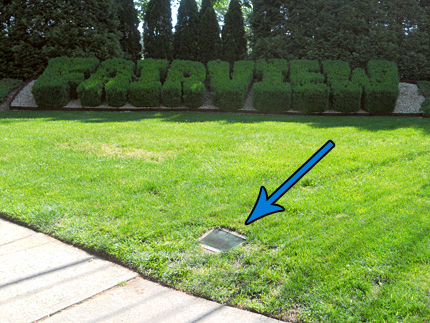
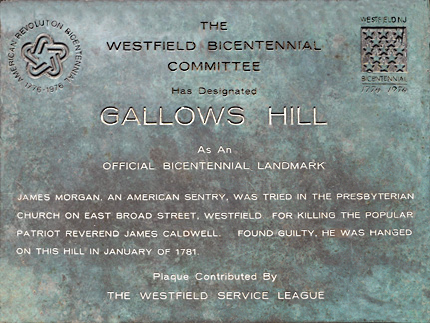
Gallows Hill Plaque
East Broad St. and Gallows Hill Rd.
In front of the Fairview Cemetery
Map / Directions to Gallows Hill
Map / Directions to all Westfield Revolutionary War Sites
This plaque at the corner of East Broad Street and Gallows Hill Road marks the site of "Gallows Hill," where American sentry James Morgan was hanged for killing James Caldwell in Elizabeth on November 24, 1781.
After being found guilty when tried at the Presbyterian Church in Westfield (see above entry ), Morgan was hanged on Gallows Hill on January 29, 1782. (The plaque mistakenly says the hanging took place in 1781). [8]

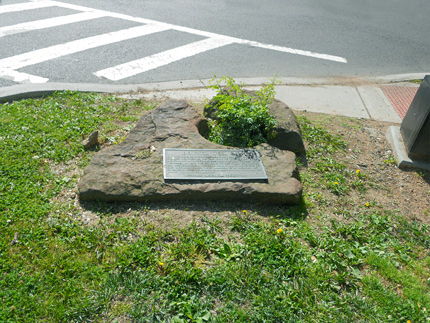
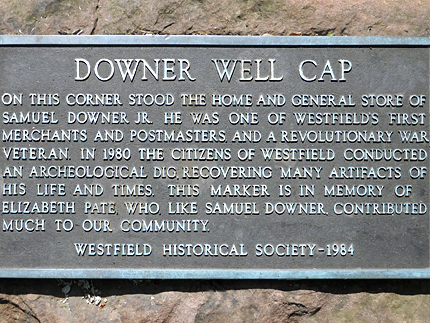
Downer Well Cap
East Broad St. and Mountain Ave.
Map / Directions to the Downer Well Cap
Map / Directions to all Westfield Revolutionary War Sites
The "Downer Well Cap" plaque is located at the corner of East Broad Street and Mountain Avenue, adjacent to the Presbyterian Church. It marks the site of the home and general store of Samuel Downer, Jr., (May 24,1760 - May 29,1846). Downer served in the Revolutionary War as a Private in the Essex County militia. [9] He was a prominent local citizen after the war. In 2012, he was inducted by The Westfield Historical Society into the Westfield Hall of Fame. [10]
Samuel Downer, Jr. and his father Samuel Downer, Sr., also a Revolutionary War veteran, are both buried in the Westfield Presbyterian Church Cemetery. [11]

1. ^ Information about the history of the church and the four church structures dating back to 1728 was drawn from:
• William K. McKinney, Ph. D, Chas. A. Philhower, A. M., Harry A. Kniffin, Commemorative History of Presbyterian Church in Westfield, New Jersey, 1728-1928 (Presbyterian Church in Westfield, N.J., 1929)
Available to be read at the Hathi Trust Digital Library website here• Boulder monument plaque in front of the church, erected by Westfield Chapter Daughters of the American Revolution in 1935
• State of New Jersey historic sign at the church
• Westfield Historic Site - Meeting House plaque which sits at the site of the second church, across the street from the current church. The plaque states, "researched by Westfield Historical Society."
2. ^ While several books and articles state that the bell incident occurred after the Battle of Springfield in 1780, my own conclusion is that the evidence points to it having occurred at the end of the Battle of the Short Hills. The sources consulted about the bell incident include:
• Jacob Ludlum testimony for Revolutionary War pension.
Retrieved from Fold3.com records.
▸ Ludlum's testimony clearly places the bell incident at the end of the June 26, 1777 Battle of the Short Hills, rather than the June 23, 1780 Battle of Springfield:~ In his description of his service in 1777, he states:
"The British sent out a strong force from Amboy through Bonhamtown, + we had a severe fight with them at Short Hills,"
and then
"The British came to Westfield where they were encamped over night. The wounded of our men were hurried off from the village in carts + wagons. The British destroyed much private household property wantonly + besides killed vast numbers of sheep, hogs + cattle. They filled the church with a flock of sheep, placed an old Ram's head with a huge pair of horns in the pulpit + carried away the bell."~ In the section describing his militia service in 1779 and 1780, he states, "We were all out on alarm duty one month at the battle + burning of Springfield + the farms in June. I performed this tour under a Captain Mulford." He makes no mention of Westfield or the bell in this section related to the Battle of Springfield.
▸ Note that Ludlum's reference to "the farms" refers to the Battle of Connecticut Farms, which was June 7, 1780, sixteen days before the Battle of Springfield.
• Frederick.C. Detwiller, War in the Countryside, Battle and Plunder of the Short Hills, June 26, 1777 (Plainfield, NJ: Interstate Printing Corporation, 1977)• Pastor James M. Huntting, A Sermon Containing a General History of the Parish of Westfield, N.J., Preached January 1, 1839, in the Presbyterian Church of that Place (Elizabeth-Town, NJ: H. H. Hassey, Printer, 1840) Page 12
~ This sermon was preached by the church's then-pastor in 1839, which was fifty-six years after the Revolutionary War ended.
He does not make specific mention of when the taking of the bell occurred.
"In the revolutionary war [the church] was much injured by the enemy. The bell was thrown out of the steeple to the ground without injury, and carried to New York. It was peculiarly fine toned, and was often heard before it was carried away, by the inhabitants of Staten Island and Chatham Village. On the first Sabbath that it was in New York, as the bells of the city began to ring for church, William Clark Esq., who was then a prisoner in the city, heard it and immediately remarked to his fellow prisoners 'that the Westfield bell must have found its way to the city.' By others who had heard it here, its ringing there was noticed, and on the return of peace, it was sought and found. As it had the name of the Parish cast on it, it was readily given up and brought back, but before it was replaced in the belfry it was broken, and materially injured."
▸ Note that the William Clark mentioned is one of the Revolutionary War soldiers buried in the cemetery of the Presbyterian Church in Westfield.• Rev. Newton W. Caldwell, "Brief History of Westfield," in F. W. Ricord, editor, History of Union County New Jersey (Newark: East Jersey History Company, 1897) Page 514- 519
Available to be read at the Internet Archive here~ Caldwell states that the bell incident occurred after the Battle of Springfield, which is most likely an error. It contradicts the testimony of Jacob Ludlum described above. In addition, the bell incident just does not fit the known facts about the Battle of Springfield.
~ Caldwell mentions the bell incident in the course of his longer narrative about the "Old One Horn" cannon, which is refuted by Ralph H. Jones in the articles listed next.
~It appears that Caldwell's account is the basis for later authors who also stated it occurred at that time.
• Ralph H. Jones, The Westfield Leader - A four-part series called "Old One Horn," which was part of a larger series called "History of Westfield." The four parts appeared on four consecutive Thursday editions of the Westfield Leader from December 28, 1989 to January 18, 1990.
PDF's of these editions are available at the Digifind-It website. Note that the files are large, and may take some time to open:
~ Dec. 28, 1989 (Article is on Page 6)
~ Jan. 4, 1990 (Article is on Page 5)
~ Jan. 11, 1990 (Article is on Page 5 and 12)
~ Jan. 18, 1990(Article is on Page 6)~ The focus of these articles is on the "Old One Horn" cannon, which sits in Fairview Cemetery in Westfield. The articles refute Newton M. Caldwell's story about the "Old One Horn" cannon which appeared in History of Union County New Jersey in 1897.
While the bell incident is not the focus of these articles, Jones does mention it in the January 18th article and states that he believed the bell incident likely occurred at the end of the Battle of the Short Hills. Furthermore, if Caldwell's story about "Old One Horn" being captured at the Battle of Springfield is incorrect, then it follows that he is likely incorrect about the bell incident occurring at that time.
3. ^ For more information and accompanying source notes about the Battle of the Short Hills, see the Battle of the Short Hills Monument entry on the Scotch Plains page.
4. ^ Jacob Ludlum testimony for Revolutionary War pension.
Retrieved from Fold3.com records.5. ^ Pastor James M. Huntting, A Sermon Containing a General History of the Parish of Westfield, N.J., Preached January 1, 1839, in the Presbyterian Church of that Place (Elizabeth-Town, NJ: H. H. Hassey, Printer, 1840) Page 12
6. ^William K. McKinney, Ph. D, Chas. A. Philhower, A. M., Harry A. Kniffin, Commemorative history of Presbyterian Church in Westfield, New Jersey, 1728-1928 (Presbyterian Church in Westfield, N.J., 1929) Page 106
Available to be read at the Hathi Trust Digital Library website here• For more information about James Caldwell, see the town pages linked from within the text.
7. ^ List of soldiers drawn from two plaques in the cemetery:
• The first was erected by the West Fields Chapter No. 11 New Jersey Society, Sons of the American Revolution on July 4, 1942, and listed the names of fifty-one soldiers then known to be buried here.
• The second was erected February 22, 1989, by the West Fields Chapter No. 11 New Jersey Society, Sons of the American Revolution, and the Westfield Chapter 2-073 NJ of the National Society Daughters of the American Revolution. It lists an additional twenty Revolutionary War soldiers "whose cemetery records were discovered after 1942."
8. ^ New Jersey Gazette, Vol. V., No. 216, February 13, 1782, contained the following short article:
"On Tuesday the 29th ult. James Morgan was executed at Westfield, pursuant to his sentence, for the wilful murder of the Rev. James Caldwell. A sermon upon the occasion was preached by the Rev. Jonathan Elmer, from Jer. xliv. 4. 'Oh! do not this abominable thing that I hate.' "
["ult." is an abbreviation for "ultimo," meaning last month. So "Tuesday the 29th ult." refers to the 29th of the previous month, January.]
▸ This article was reprinted in:
Austin Scott, Ed., Archives of the State of New Jersey, Second Series, Vol. V. (Trenton, Star Gazette Publishing Company, 1917) page 371
Available to be read at the Internet Archive hereRalph H. Jones, Concluding article of the "James Morgan: Guilty as Charged?," which was part of a larger series called "History of Westfield," The Westfield Leader, March 1, 1990, page 5
PDF of this edition is available at the Digifind-It website here• The Gallows Hill site is marked by a Westfield Bicentennial Committee plaque, placed by the Westfield Service League
9. ^ Information drawn from:
• Downer Well Cap plaque, erected by the Westfield Historical Society in 1984.
• D.A.R. Genealogical Research System, where Samuel Downer Jr. is Ancestor # A034157
10. ^ Westfield Hall of Fame 2012 page of the Westfield Historical Society website
11. ^ Gravestones and markers in the cemetery of the Presbyterian Church in Westfield